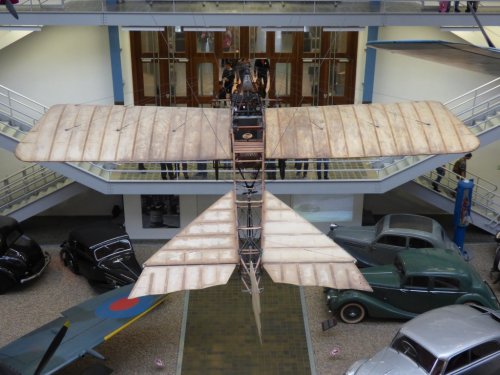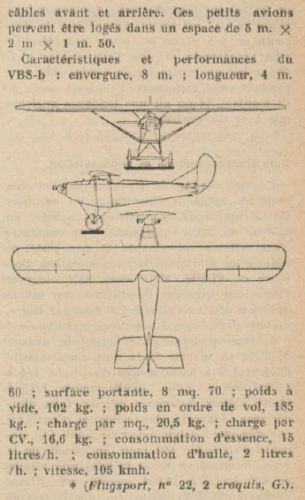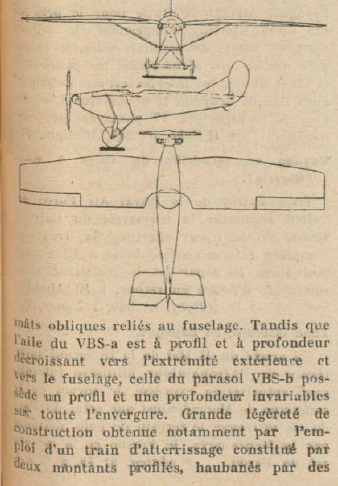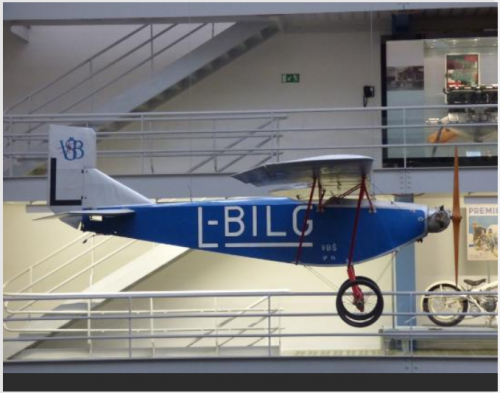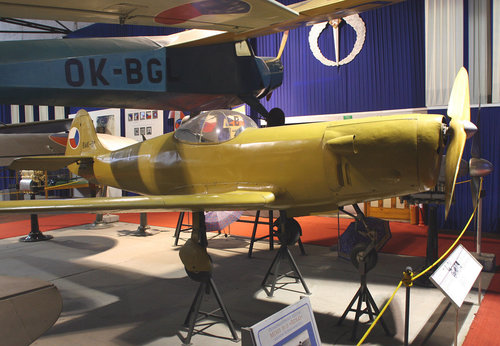You are using an out of date browser. It may not display this or other websites correctly.
You should upgrade or use an alternative browser.
You should upgrade or use an alternative browser.
Various Czechoslovak Little Known Designers & Aircraft
- Joined
- 6 September 2006
- Messages
- 4,620
- Reaction score
- 8,609
Here is some data I got from a website some time ago.
P.14 7.89m span, speed about 630mph, 1x MK108 30mm
P.4 single-seat advanced trainer 7.62m span, 1x Argus As 10c piston driving a tractor propeller, provision for one 7.92mm MG in wing and light bombs. In appearance it loked very much like a mini FW190. I think it flew in 1944 but I'm not entirely sure.
Also some data on the Aero 304/404.
Aero A.304/404 1936 span 19.20m, length 13.20m height 3.40m and wng area 46m2, A.304 2x360hp Walter Pollux IIR piston engines or A.404 430hp Walter Super Castor I-MR, max speed 199mp, range 560 miles. The armament of the A.404 was 2x7.9mm MG in nose and dorsal mounts and bombs. The A.304 carried 2crew + 10 passengers and the A.304 3 crew.
Sorry I have no pictures to add.
P.14 7.89m span, speed about 630mph, 1x MK108 30mm
P.4 single-seat advanced trainer 7.62m span, 1x Argus As 10c piston driving a tractor propeller, provision for one 7.92mm MG in wing and light bombs. In appearance it loked very much like a mini FW190. I think it flew in 1944 but I'm not entirely sure.
Also some data on the Aero 304/404.
Aero A.304/404 1936 span 19.20m, length 13.20m height 3.40m and wng area 46m2, A.304 2x360hp Walter Pollux IIR piston engines or A.404 430hp Walter Super Castor I-MR, max speed 199mp, range 560 miles. The armament of the A.404 was 2x7.9mm MG in nose and dorsal mounts and bombs. The A.304 carried 2crew + 10 passengers and the A.304 3 crew.
Sorry I have no pictures to add.
- Joined
- 28 January 2008
- Messages
- 631
- Reaction score
- 480
Eugen (Eugene) Čihák Rapid (1912)
One of the first pioneer designers of Czech aviation, Eugen (Eugene) Čihák was born on May 31, 1885 in Vinkovič in Croatia in what is now Yugoslavia. His father Ing.František Čihák worked in the service of the Austro-Hungarian Railways. Mother Marie Čiháková born in Kasparov and was the cousin to Ing. Jan Kaspar, the first Czech aviator.
Eugen Čihák and Jan Kašpar built a workshop at the army training field at Pardubice (Czech Kingdom, part of Austria-Hungary) and in 1910 they finished the monoplane powered with a Kašpar-Čihak design of unknown power rating, of their own design. The monoplane made only short hops due to engine of low power so they decided to mount engine Anzani of 25 HP. Jan Kašpar made a ten minutes flight and then he crashed on the first flight and the aircraft wrecked. Kašpar went to France and there bought a new monoplane Blériot, which he later used as a basis for his own design, the Kaspar JK (see next post).
Eugene Čihák designed the pre-war Rapid with his brother Hugo, which outclassed most of the contemporary types. It was a single-seat monoplane and was built along the lines of early Morane monoplanes. Pyramidal tube raised tower in front of the pilot and behind the rotary engine allowed the bracing wires to go down to the wings.
The photo of the Čihák Rapid (1912) is from the early years of flight gallery at Národní Technické Muzeum (NTM) Prague.
One of the first pioneer designers of Czech aviation, Eugen (Eugene) Čihák was born on May 31, 1885 in Vinkovič in Croatia in what is now Yugoslavia. His father Ing.František Čihák worked in the service of the Austro-Hungarian Railways. Mother Marie Čiháková born in Kasparov and was the cousin to Ing. Jan Kaspar, the first Czech aviator.
Eugen Čihák and Jan Kašpar built a workshop at the army training field at Pardubice (Czech Kingdom, part of Austria-Hungary) and in 1910 they finished the monoplane powered with a Kašpar-Čihak design of unknown power rating, of their own design. The monoplane made only short hops due to engine of low power so they decided to mount engine Anzani of 25 HP. Jan Kašpar made a ten minutes flight and then he crashed on the first flight and the aircraft wrecked. Kašpar went to France and there bought a new monoplane Blériot, which he later used as a basis for his own design, the Kaspar JK (see next post).
Eugene Čihák designed the pre-war Rapid with his brother Hugo, which outclassed most of the contemporary types. It was a single-seat monoplane and was built along the lines of early Morane monoplanes. Pyramidal tube raised tower in front of the pilot and behind the rotary engine allowed the bracing wires to go down to the wings.
The photo of the Čihák Rapid (1912) is from the early years of flight gallery at Národní Technické Muzeum (NTM) Prague.
Attachments
- Joined
- 28 January 2008
- Messages
- 631
- Reaction score
- 480
Kaspar JK-Bleriot (1911)
One of the most important figures in early Czech aviation was Ing. Jan Kaspar from Pardubice. Kaspar was one of the early figures to successfully fly a heavier than air machine. As early as April 1910 he made short test flights at Pardubice in an imported Bleriot XI monoplane.
In 1913 he constructed his own all-wooden aeroplane which was derived directly from his original Bleriot. Instead of the original 3-cylinder Anzani engine, Kaspar installed a water-cooled 4-cylinder Daimler (70 hp) motor. This led to a top speed of 90-100 km/h.
In this machine Kaspar made the first real long-distance flight in Czech history on 13th May 1911. It lasted 92 minutes and Kaspar covered 121 km from Pardubice to Prague.
Kašpar later donated the aircraft in which he flew to Prague to the Technical Museum of the Czech Kingdom in 1913. Today, suspended in the transportation hall of the Národní Technické Muzeum, it is one of the most significant exhibits documenting Czech history of aviation. The aircraft was completely restored in 1966.
Jan Kašpar was the cousin of fellow Czech pioneer Eugene Čihák. Kašpar died on 2 March 1927.
Source:
Národní Technické Muzeum
One of the most important figures in early Czech aviation was Ing. Jan Kaspar from Pardubice. Kaspar was one of the early figures to successfully fly a heavier than air machine. As early as April 1910 he made short test flights at Pardubice in an imported Bleriot XI monoplane.
In 1913 he constructed his own all-wooden aeroplane which was derived directly from his original Bleriot. Instead of the original 3-cylinder Anzani engine, Kaspar installed a water-cooled 4-cylinder Daimler (70 hp) motor. This led to a top speed of 90-100 km/h.
In this machine Kaspar made the first real long-distance flight in Czech history on 13th May 1911. It lasted 92 minutes and Kaspar covered 121 km from Pardubice to Prague.
Kašpar later donated the aircraft in which he flew to Prague to the Technical Museum of the Czech Kingdom in 1913. Today, suspended in the transportation hall of the Národní Technické Muzeum, it is one of the most significant exhibits documenting Czech history of aviation. The aircraft was completely restored in 1966.
Jan Kašpar was the cousin of fellow Czech pioneer Eugene Čihák. Kašpar died on 2 March 1927.
Source:
Národní Technické Muzeum
Attachments
- Joined
- 26 May 2006
- Messages
- 33,572
- Reaction score
- 13,701
- Joined
- 26 May 2006
- Messages
- 33,572
- Reaction score
- 13,701
Re: Various Czechoslovak Civil Aircraft
It was called Simunek VBS-1
<a href="https://www.tripadvisor.com/LocationPhotoDirectLink-g274707-d318617-i163588069-National_Technical_Museum-Prague_Bohemia.html#163588069"><img alt="" src="https://media-cdn.tripadvisor.com/media/photo-s/09/c0/27/e5/national-technical-museum.jpg"/></a>
This photo of National Technical Museum is courtesy of TripAdvisor
hesham said:From Le Document Aeronautique 1928,
I can't ID those two airplanes or they were a Projects or not ?.
It was called Simunek VBS-1
<a href="https://www.tripadvisor.com/LocationPhotoDirectLink-g274707-d318617-i163588069-National_Technical_Museum-Prague_Bohemia.html#163588069"><img alt="" src="https://media-cdn.tripadvisor.com/media/photo-s/09/c0/27/e5/national-technical-museum.jpg"/></a>
This photo of National Technical Museum is courtesy of TripAdvisor
Attachments
- Joined
- 25 July 2007
- Messages
- 4,167
- Reaction score
- 3,835
Re: Various Czechoslovak Civil Aircraft
So, the shoulder-winged VBŠ-a project was dropped in favour of the parasol VBŠ-b - built in 1926 as the prototype VBŠ-1. The VBŠ-1 was otherwise known as the VBŠ Kuňkadlo.
The VBŠ-1 was designed by the brothers Vladimír and Bohuslav Šimůnkov. The latter is often listed as an engine designer for Walter (I assume by confusing him with Ing. Bohumil Šimůnek who designed of the HO2 Praga B for ČKD Praga before going on to the Walter Mikron and Minor series).
BTW, does anyone know if the current aircraft designer Ing. Jan Šimůnek is related to Vladimír and Bohuslav?
hesham said:It was called Simunek VBS-1
So, the shoulder-winged VBŠ-a project was dropped in favour of the parasol VBŠ-b - built in 1926 as the prototype VBŠ-1. The VBŠ-1 was otherwise known as the VBŠ Kuňkadlo.
The VBŠ-1 was designed by the brothers Vladimír and Bohuslav Šimůnkov. The latter is often listed as an engine designer for Walter (I assume by confusing him with Ing. Bohumil Šimůnek who designed of the HO2 Praga B for ČKD Praga before going on to the Walter Mikron and Minor series).
BTW, does anyone know if the current aircraft designer Ing. Jan Šimůnek is related to Vladimír and Bohuslav?
archipeppe
ACCESS: Top Secret
- Joined
- 18 October 2007
- Messages
- 2,376
- Reaction score
- 2,781
I can't ID this well,maybe from CNA and called BAK,but I never heard about it before ?.
Odd, never seen such plane before.
Even more odd the tri-cycle landing gear rarely seen in Italian aircraft up to WWII.
Looks more like Czech stuff with an Italian engine...
Aubi
ACCESS: Secret
Amateur sporting aircraft made by the students of Liberec military technical school, led by the seasoned pilot capt. Jan Červinka, 1948-1949. ČNA means Český národní aeroklub, Czech National Aeroclub, and the makers formally belonged under it. VOSM means Vojenská odborná škola leteckých mechaniků, Military Technical School of Aviation Mechanics. Weird little thing.
- Joined
- 26 May 2006
- Messages
- 33,572
- Reaction score
- 13,701
Thank you my dears,
and please Moderator,we can transfer it to this topic;
and please Moderator,we can transfer it to this topic;
swscotland
ACCESS: Restricted
- Joined
- 11 February 2020
- Messages
- 2
- Reaction score
- 3
Amateur sporting aircraft made by the students of Liberec military technical school, led by the seasoned pilot capt. Jan Červinka, 1948-1949. ČNA means Český národní aeroklub, Czech National Aeroclub, and the makers formally belonged under it. VOSM means Vojenská odborná škola leteckých mechaniků, Military Technical School of Aviation Mechanics. Weird little thing.
Does the BAK stand for something?
I tried to read the PDF posted by Hesham - Google translate is great but often produces some ambiguous sentences. The article talks about the BAK (Flown by Jan Červenka) breaking a world record in 1948 in the category "less than 2 litres" - presumably the engine size. Am I reading this correctly?
Aubi
ACCESS: Secret
Sorry, I didn't find anything about the meaning of BAK. Presumably, B stands for Robert Binder, its chief designer.
You're right about the 2 litres thing, it is engine volume.
You're right about the 2 litres thing, it is engine volume.
- Joined
- 26 May 2006
- Messages
- 33,572
- Reaction score
- 13,701
Welcome aboard Swscotland,
but as you said,hard to get the comprehensive meaning from google translate;
Cervinka skutecne during the three years in which it was measured maximum speed 252 km / h
broke the current speed record and created new ones in category H (aircraft capacity up to 2 liters).
but as you said,hard to get the comprehensive meaning from google translate;
Cervinka skutecne during the three years in which it was measured maximum speed 252 km / h
broke the current speed record and created new ones in category H (aircraft capacity up to 2 liters).
Aubi
ACCESS: Secret
That sentence has very complicated structure and poor Google can't understand. From the beginning of the sentence:
"After few strolls and small jumps, which were performed by pilots Červinka and Eliáš, was BAK during autumn transferred to Žatec, where Major Červinka, after flight testing, during three flights which gave max speed readings of 252 km/hr, really broke the world speed record and made new one in the H cathegory (aircraft with 2 litres of engine volume)."
"After few strolls and small jumps, which were performed by pilots Červinka and Eliáš, was BAK during autumn transferred to Žatec, where Major Červinka, after flight testing, during three flights which gave max speed readings of 252 km/hr, really broke the world speed record and made new one in the H cathegory (aircraft with 2 litres of engine volume)."
swscotland
ACCESS: Restricted
- Joined
- 11 February 2020
- Messages
- 2
- Reaction score
- 3
That sentence has very complicated structure and poor Google can't understand. From the beginning of the sentence:
"After few strolls and small jumps, which were performed by pilots Červinka and Eliáš, was BAK during autumn transferred to Žatec, where Major Červinka, after flight testing, during three flights which gave max speed readings of 252 km/hr, really broke the world speed record and made new one in the H cathegory (aircraft with 2 litres of engine volume)."
Thanks. I read this as meaning he had set an "unofficial" record in the category. I looked on FAI's website and though Jan Červenka held several records, there were none after 1938.
- Joined
- 9 October 2009
- Messages
- 21,147
- Reaction score
- 12,249
I looked on FAI's website and though Jan Červenka held several records, there were none after 1938
Doubtless due to Czechoslovakia's dismemberment and ultimate destruction at the hands of the Nazis.
- Joined
- 25 July 2007
- Messages
- 4,167
- Reaction score
- 3,835
Sorry, I didn't find anything about the meaning of BAK. Presumably, B stands for Robert Binder, its chief designer...
If 'B' was for Binder, 'AK' might have been for AeroKlubu as in Českého národního aeroklubu ... since Aeroklubu Liberec ČNA members were attached to VOŠLM.
Aubi
ACCESS: Secret
Czechoslovakia was dismantled by nazis, but it was restored in 1945 and this machine flew in 1948... Anyway, I agree with the idea that the record was unofficial, Žatec is fairly small and I would'nt expect FAI officials wandering there often. Also BAK flew only few times, its engine (Walter Mc aka M-431) was a prototype and soon it started behaving erratingly. It was then was removed and send back to the factory for adjustments and the machine back to Liberec. Soon after, as the article says, "the international political situation changed", i.e. the communist government started tightening the screws, and BAK never flew again. When the VOŠLM moved to Slovakia and BAK with it, where it existed "under development" until 1969, when was BAK transferred to Military History Institute in Prague and subsequently to Kbely.
I saw it several times in the Kbely museum, and never knew what it was. Shame.
AK could definitely mean aeroklubový, i.e. "for aeroclubs", or maybe akrobatický, "aerobatic", or something similar. BAK itself doesn't mean nothing in Czech. maybe there's something about it on the description table in the museum, but i doubt it, and I wouldn't be there again until summer.
I saw it several times in the Kbely museum, and never knew what it was. Shame.
AK could definitely mean aeroklubový, i.e. "for aeroclubs", or maybe akrobatický, "aerobatic", or something similar. BAK itself doesn't mean nothing in Czech. maybe there's something about it on the description table in the museum, but i doubt it, and I wouldn't be there again until summer.
- Joined
- 28 January 2008
- Messages
- 631
- Reaction score
- 480
Štasik Dreadnought No1
In the Journal LHS No 1, there was a photo and brief description of an early Czech twin-engine bomber which bore the description Štasik Dreadnought No1 dating from 1914. It was a large pusher-pull-me biplane which was not very successful.
The aircraft was built in Prague by designer Jan Štasik. Design started in 1913 and the build completed in early summer of 1914. It was possibly the first twin-engine aircraft to be completed in the Austro-Hungarian Empire. The aeroplane carried two crew members who sat in tandem behind the tractor engine. The second engine was at the rear of the fuselage pushing from behind. The bomb load was to be carried in the fuselage behind the crew.
In the autumn of 1914 the completed machine was transported from Prague to Fishamend airfield near Vienna, Austria. It was here that flight trials were to be undertaken. However, the aircraft crashed during the initial take-off attempt when the forward undercarriage collapsed when taxying at high speed. The aircraft was never rebuilt and the aircraft largely forgotten.
Details:
Engines: 2x Gnome Rotary (100 hp)
Wing span: 18.0 m
Empty weight: 750 kg
Normal weight: 1,200 kg
Estimated maximum weight: 2,000 kg
Maximum speed: 150 km/h
Endurance: 6 hours
Crew: Two
Source:
Article entitled “The First Czech Bomber” from Ceskoslovenska Letecka Historicka Spolecnost (LHS) No 1
In the Journal LHS No 1, there was a photo and brief description of an early Czech twin-engine bomber which bore the description Štasik Dreadnought No1 dating from 1914. It was a large pusher-pull-me biplane which was not very successful.
The aircraft was built in Prague by designer Jan Štasik. Design started in 1913 and the build completed in early summer of 1914. It was possibly the first twin-engine aircraft to be completed in the Austro-Hungarian Empire. The aeroplane carried two crew members who sat in tandem behind the tractor engine. The second engine was at the rear of the fuselage pushing from behind. The bomb load was to be carried in the fuselage behind the crew.
In the autumn of 1914 the completed machine was transported from Prague to Fishamend airfield near Vienna, Austria. It was here that flight trials were to be undertaken. However, the aircraft crashed during the initial take-off attempt when the forward undercarriage collapsed when taxying at high speed. The aircraft was never rebuilt and the aircraft largely forgotten.
Details:
Engines: 2x Gnome Rotary (100 hp)
Wing span: 18.0 m
Empty weight: 750 kg
Normal weight: 1,200 kg
Estimated maximum weight: 2,000 kg
Maximum speed: 150 km/h
Endurance: 6 hours
Crew: Two
Source:
Article entitled “The First Czech Bomber” from Ceskoslovenska Letecka Historicka Spolecnost (LHS) No 1
Attachments
Similar threads
-
-
-
-
Little-Known French Projects and Prototypes
- Started by hesham
- Replies: 736
-
Ricci Bros Projects: between the aerial motorcycle and the flying transatlantic
- Started by ermeio
- Replies: 45



